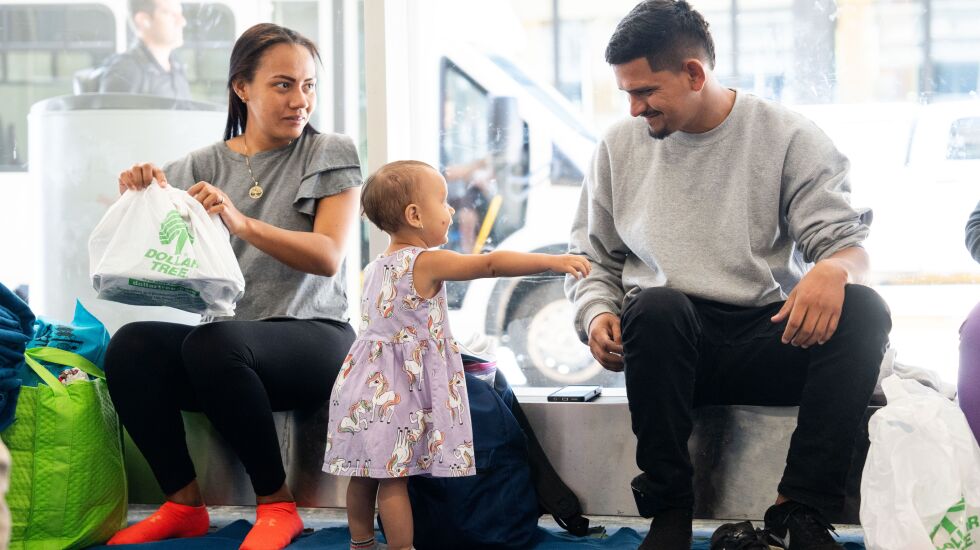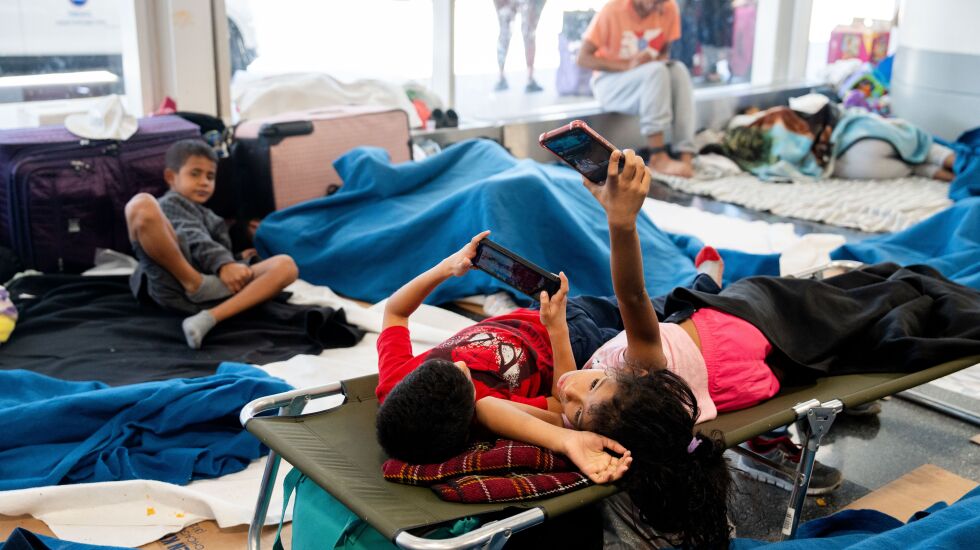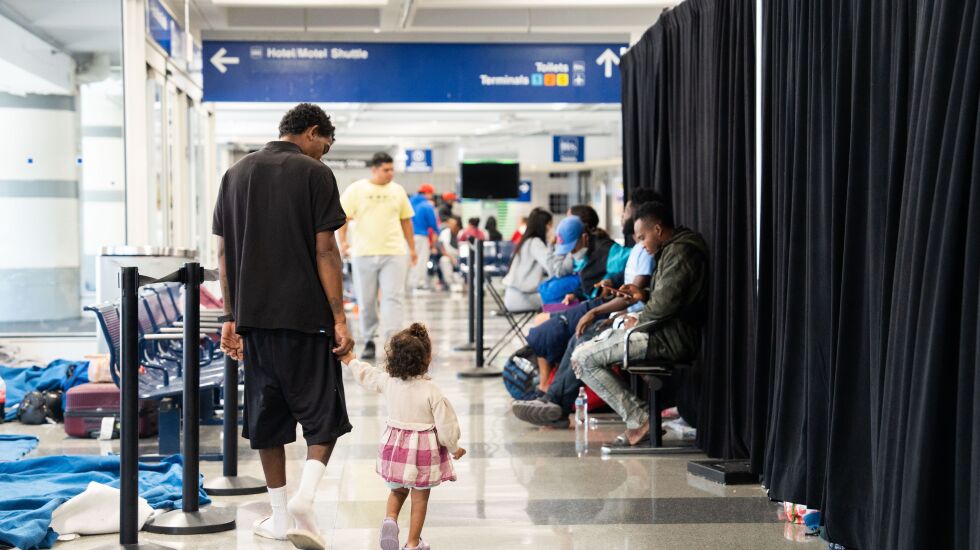
When Alberto Davila, a new immigrant from Venezuela, was given plane tickets last month to come to Chicago from San Antonio, Texas, a long stay in O’Hare Airport isn’t what he and his family were told to expect.
“What a surprise this was,” Davila said, looking around at the hundreds of people sleeping head-to-toe at O’Hare. “I thought we’d be at a shelter, a stable place where we could work and our kids could get an education.”
Davila, 28, his wife and two kids are among the thousands arriving at the airport with tickets bought by Catholic Charities of San Antonio using federal dollars.
Many say they were told that in Chicago, they’d have help starting a new life. Instead, they have found themselves at O’Hare in an overcrowded “landing zone,” as it’s called by the city.
That growth is mostly because of the San Antonio Catholic Charities group, according to the city, though there also have been arrivals from other places, such as Houston and New York City. The nonprofit has continued sending migrants despite the city’s insistence that it’s at capacity.
Many said they are grateful to have shelter at all but are surprised by the living conditions.
On Monday, 549 people were living at O’Hare, according to the city, but the number of people camped out at the airport had ballooned to over 800 in earlier this month, around twice as many as the start of September, when the Sun-Times first reported on the growing crisis at O’Hare. There are currently 3,700 people waiting for space in city shelters to open up.
The airport became an unofficial shelter in June when more migrants arriving by plane and buses left police stations too crowded to bring people there.
The number of migrants at the airport, however, has grown so much that they’re now camped out on flattened cardboard boxes throughout the entire ground-floor space.
More than 2,000 migrants arrived via plane from San Antonio between June 3 and Sept. 15, according to the latest available numbers from the city.

Many, like Davila, told the Sun-Times they came to Chicago at the recommendation of Catholic Charities in San Antonio.
Jefferson Ugueto, his wife and 3-year-old daughter said they were directed to come because it’s closer to their ultimate destination — upper Minnesota, where they were told by Catholic Charities there’s a shelter.
Now that they’re in Chicago, they say they have no idea how they’ll make the rest of the journey to the small town near the North Dakota border.
“We have no money,” said Ugueto, 27. “I don’t know what we’re going to do.”
Leaders at Catholic Charities in San Antonio have said sending migrants via plane is more humane than busing them, which can be a lengthy journey, during which one migrant toddler died in August.
“How would you feel about being in a bus for two days without knowing the language?” asked Antonio Fernandez, CEO of the San Antonio nonprofit.
Since a phone call with Mayor Brandon Johnson’s administration in early September about the strain put on the city by the arrival of more migrants, Fernandez said the charity has been encouraging migrants to pick a destination other than Chicago if they don’t have a sponsor.
“We recommend people not to go to Chicago,” he said, but, “we cannot force them.”
In the week after that phone call, the number of arrivals from San Antonio, the vast majority of whom are sent by Catholic Charities, still grew by 33%, according to city data.
Fernandez, who became CEO of Catholic Charities in Texas after several years with Catholic Charities in Chicago, said the organization in San Antonio had been forced to become a transportation hub because of the sheer number of people crossing the border.
More than 18,500 migrants have arrived in Chicago in the last year, requiring city assistance, but the number going through the organization’s San Antonio welcoming center was more than 10 times that, according to Fernandez. Top destinations, Fernandez said, included New York, Miami and Chicago, although he said the charity does not keep a record of where it sends people.
Catholic Charities doesn’t shelter people for extended stays. There were over 11,200 people at the city’s 20 shelters on Wednesday and over 3,300 at Chicago police stations.

The plane tickets are paid for using funds from the Federal Emergency Management Agency, Fernandez said. The nonprofit has been awarded $48 million through FEMA’s Emergency Food and Shelter Program since December. That’s compared to about $7 million awarded to Chicago, according to FEMA.
Those funds are spent on staffing the welcoming center to ensure they deliver “trauma-informed care,” according to Fernandez, but most is spent on transportation.
Cristina Pacione-Zayas, first deputy chief of staff for Johnson, confirmed the mayor’s call with Fernandez last month. She said she understood “they’re trying to manage” a high number of arrivals but called what they were doing “reckless.”
“They’re trying to displace the responsibility,” she said of Catholic Charities.
Onomir, a migrant who asked to be identified by her first name only, told the Sun-Times about her stay at O’Hare with her daughter. She said they spent nearly a week without a shower or a bed.
“That was inhumane,” she said.
By August, others were telling the Sun-Times that they were staying at O’Hare for as long as three weeks.
“We don’t have everything we want or need, but at least we’re not out on the street,” said Ender Morin, 35, another migrant arrival from Catholic Charities in San Antonio.

The wait can be especially hard for those with children, many of whom are sick from the food or cold floors, parents say.
“We all came here to work,” said Maria Sánchez, who said she had been at the airport for nearly a week with her two kids. “I thought we’d be able to go out and get a better life.”
Even adults without kids can find it difficult.
Cesar Zambrado complained of being hungry, of food that would “send you to the toilet,” long lines to use a microwave to reheat food and boredom.
Above all, the 32-year-old said he wanted a change of clothes. He said he had been wearing the same clothes for weeks since leaving a California detention center.
“I thought I would arrive and be able to get into a shelter and start looking for work,” he said, ruefully. “It’s been very hard.”

Michael Loria is a staff reporter for the Chicago Sun-Times via Report for America, a not-for-profit journalism program that aims to bolster the paper’s coverage of communities on the South Side and West Side.







